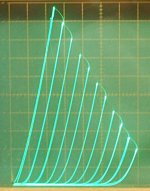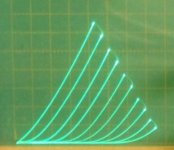Greetings,
I'm interested in learning how tubes work in preamp circuits. For experimentation purposes I'm looking into investing in a few sub miniature tubes for the following reasons:
Low voltage. I'm absent minded and would prefer to be more familiar with electronics before I conduct experiments at higher voltages. Buying a pcb and following directions online is one thing but once I start fiddling around with my own circuits I could get distracted.
Size. The wire leads will fit nicely in a bread board and I'm also attracted to the idea of creating something little larger than a walnut.
Cost. If I'm just experimenting then it's better to invest in a couple of bench top power supplies. Higher voltage means higher cost.
I bought a subminiature diode on ebay to inspect/conduct experiments to reaffirm what I'm reading in books. The seller informed me that a power supply for the plate voltage of this diode could go around 50v. That being said the graphs in the data sheet don't show the plate voltage beyond 8v.
How does one determine how hot to run the plate?
Here's the data sheet I'm referring to: https://frank.pocnet.net/sheets/137/5/5647.pdf
I'm interested in learning how tubes work in preamp circuits. For experimentation purposes I'm looking into investing in a few sub miniature tubes for the following reasons:
Low voltage. I'm absent minded and would prefer to be more familiar with electronics before I conduct experiments at higher voltages. Buying a pcb and following directions online is one thing but once I start fiddling around with my own circuits I could get distracted.
Size. The wire leads will fit nicely in a bread board and I'm also attracted to the idea of creating something little larger than a walnut.
Cost. If I'm just experimenting then it's better to invest in a couple of bench top power supplies. Higher voltage means higher cost.
I bought a subminiature diode on ebay to inspect/conduct experiments to reaffirm what I'm reading in books. The seller informed me that a power supply for the plate voltage of this diode could go around 50v. That being said the graphs in the data sheet don't show the plate voltage beyond 8v.
How does one determine how hot to run the plate?
Here's the data sheet I'm referring to: https://frank.pocnet.net/sheets/137/5/5647.pdf
While valves will work at low voltages that doesn't always give good results.
I am used to supply a few hundred volt to them.
You might be better going solid state to stay safe.
A good grounding in SS will help you move to valves later.
I am used to supply a few hundred volt to them.
You might be better going solid state to stay safe.
A good grounding in SS will help you move to valves later.
Well, I've already invested in a couple of books on tubes, which I'm now reading simultaneously. Do you have any books to recommend? I prefer explanations that are extremely light on math before I move on to more complicated calculations.
Keep in mind that I went to an inner city high school. In the states that means I got a very poor education. Then I dropped out to go to art school, which has no math coursework. I'm willing to do the work but I do have a curve against me. I'm currently finding Norman Crowhurst's Basic Audio just my speed.
Keep in mind that I went to an inner city high school. In the states that means I got a very poor education. Then I dropped out to go to art school, which has no math coursework. I'm willing to do the work but I do have a curve against me. I'm currently finding Norman Crowhurst's Basic Audio just my speed.
If you're that concerned about high voltages, why not start with space charge tubes used in car radios?
Many low-impedance triodes work 'OK' at low voltages. The ECC88/6DJ8 can be made to work with a 50V supply, and would be an easy place to start since it is already a popular hi-fi valve. That said, my gut reaction is 'don't be such a chicken'! Preamps need very little current so the power supplies are pretty harmless. It's the mains (wall voltage) that you need to be careful with, and plenty of dullards work on that for a living, every day. Alternatively you could use a Nixie supply, which steps up from a low voltage like 9V-12Vdc to a couple of hundred volts at a few milliamps. It bites, but it's harmless. Voltage Multipliers (for our tube projects...)
Thanks, everyone, for your advice. Especially Merlin's, maybe I'll get some regular tubes after all. I can't go around having people calling me chicken after all!
Merlin, I'm contemplating getting one of your preamp books next. I perused the first chapter of your instrument book and it looks like I could dive in and create circuits with that information alone. I'm looking for a book where I can put into practice what I'm reading as I go along. I'm really a hands on kind of learner. Tactile experiences really cement information for me.
Which of your pre amp books should I start out with? I'd like to read both but I just want to know which one to get first.
Merlin, I'm contemplating getting one of your preamp books next. I perused the first chapter of your instrument book and it looks like I could dive in and create circuits with that information alone. I'm looking for a book where I can put into practice what I'm reading as I go along. I'm really a hands on kind of learner. Tactile experiences really cement information for me.
Which of your pre amp books should I start out with? I'd like to read both but I just want to know which one to get first.
High transconductance, or high gm, tubes will work at low voltages. The ECC88/6DJ8 triode as mentioned is one, but there are some that are only $1. The 6JC6 and 12HL7 pentodes are on the $1 list here:
Summer Dollar Days - Vacuum Tube Sale - $1.00 Vacuum Tubes
These can be configured as triodes as well. Great for experimenting. Datasheets here:
http://frank.pocnet.net/sheets/135/6/6JC6A.pdf
http://frank.pocnet.net/sheets/135/1/12HL7.pdf
1) 12HL7 makes a great triode:
2) and 6JC6 in triode mode:
Summer Dollar Days - Vacuum Tube Sale - $1.00 Vacuum Tubes
These can be configured as triodes as well. Great for experimenting. Datasheets here:
http://frank.pocnet.net/sheets/135/6/6JC6A.pdf
http://frank.pocnet.net/sheets/135/1/12HL7.pdf
1) 12HL7 makes a great triode:
2) and 6JC6 in triode mode:
Attachments
My hi-fi book contains basically the same chapter as my instrument book (except it's chapter 3 instead of 1), but with more of a hi-fi focus. Since you've come to a hi-fi forum I'm guessing that's what you're mostly interested in. My hi-fi book also has a chapter on power supplies, more actual circuit snippets in general, and more ink-per-dollar. So I think it's the hi-fi book you want. Yes, it does have plenty of math, but I think you can skip that and focus on the graphical and text explanations to start with, and you'll still get a lot out of it.I perused the first chapter of your instrument book and it looks like I could dive in and create circuits with that information alone.
Don't forget that you're not alone. Lots of people play around with low-voltage valve circuits (OK not so many on this forum), and post their circuits online. Just google it and you'll find all sorts. Why not crib some ideas from the many silly Chinese headphone amps out there?
https://www.eevblog.com/2016/01/07/eevblog-837-reverse-engineering-a-valve-headphone-amplifier/
- Status
- Not open for further replies.
- Home
- Amplifiers
- Tubes / Valves
- Audio Novice

